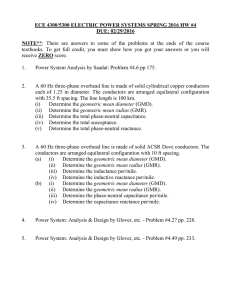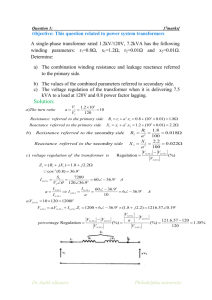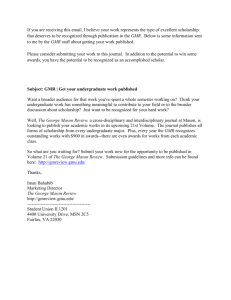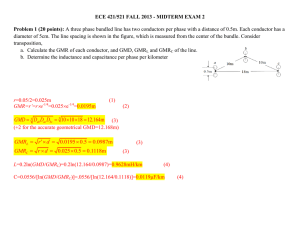Solution
advertisement
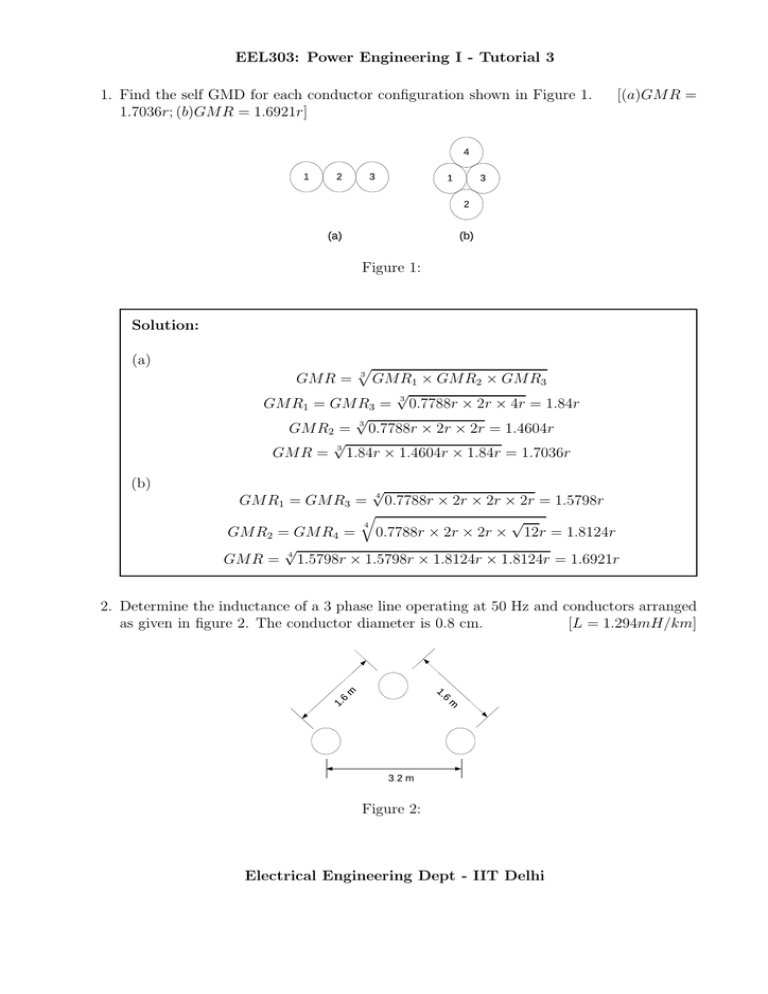
EEL303: Power Engineering I - Tutorial 3 1. Find the self GMD for each conductor configuration shown in Figure 1. 1.7036r; (b)GMR = 1.6921r] [(a)GMR = Figure 1: Solution: (a) GMR = p 3 GMR1 × GMR2 × GMR3 √ GMR1 = GMR3 = 3 0.7788r × 2r × 4r = 1.84r √ GMR2 = 3 0.7788r × 2r × 2r = 1.4604r √ GMR = 3 1.84r × 1.4604r × 1.84r = 1.7036r (b) √ GMR1 = GMR3 = 4 0.7788r × 2r × 2r × 2r = 1.5798r q √ 4 GMR2 = GMR4 = 0.7788r × 2r × 2r × 12r = 1.8124r √ GMR = 4 1.5798r × 1.5798r × 1.8124r × 1.8124r = 1.6921r 2. Determine the inductance of a 3 phase line operating at 50 Hz and conductors arranged as given in figure 2. The conductor diameter is 0.8 cm. [L = 1.294mH/km] Figure 2: Electrical Engineering Dept - IIT Delhi EEL303: Power Engineering I - Tutorial 3 Solution: GMR = 0.7788 × 0.004 = 0.0031152m p GMD = 6 (1.6 × 1.6)(1.6 × 3.2)(1.6 × 3.2) = 2.0158m L = 2 × 10−7 ln 2.0158 = 1.294mH/km 0.0031152 3. Determine the inductance of a single phase transmission line consisting of three conductors of 2.5 mm radii in the ‘go’ conductor and 5 mm radii in the return conductor. The configuration of line is as shown in figure 3.[(a)L = 1.42mH/km; (b)L = 1.485mH/km] Figure 3: Solution: (a) GMRA = p 3 GMRa × GMRb × GMRc √ GMRa = GMRc = 3 0.7788 × 0.0025 × 6 × 12 = 0.51947m √ GMRb = 3 0.7788 × 0.0025 × 6 × 6 = 0.4123m √ GMRA = 3 0.51947 × 0.4123 × 0.51947 = 0.4809m GMRB = p 4 (0.7788 × 5 × 6)(0.7788 × 5 × 6) = 0.1528m GMDA = GMDB = √ 6 9 × 10.81 × 9 × 10.81 × 10.81 × 15 = 10.74m 10.74 LA = 2 × 10−7 ln = 0.62mH/km 0.4809 Electrical Engineering Dept - IIT Delhi EEL303: Power Engineering I - Tutorial 3 LB = 2 × 10−7 ln 10.74 = 0.8mH/km 0.1528 L = LA + LB = 1.42mH/km (b) GMRA = p 3 GMRa = GMRc = √ 3 GMRb = GMRa × GMRb × GMRc 0.7788 × 0.0025 × 4 × 8 = 0.3964m √ 3 0.7788 × 0.0025 × 4 × 4 = 0.3146m √ GMRA = 3 0.3964 × 0.3146 × 0.3964 = 0.367m GMRB = GMDA = GMDB = q 6 √ √ 0.7788 × 5 × 4 = 0.1248m 68 × 10 × LA = 2 × 10−7 ln √ 68 × √ 68 × √ 68 × 10 = 8.7936m 8.7936 = 0.635mH/km 0.367 LB = 2 × 10−7 ln 10.74 = 0.85mH/km 0.1248 L = LA + LB = 1.485mH/km 4. Determine the inductance per km of a transposed double circuit 3 phase line shown in figure 4. Each circuit of the line remains on its own side. The dia of the conductor is 2.532 cm. [L = 0.606mH/km] Solution: GMRA = p 3 GMRa × GMRb × GMRc p ′ 4 ra′ Daa′ × ra′ Da′ a GMRa = √ = 4 0.7788 × 0.01266 × 10.965 × 0.7788 × 0.01266 × 10.965 = 0.3288m Electrical Engineering Dept - IIT Delhi EEL303: Power Engineering I - Tutorial 3 Figure 4: p ′ 4 GMRc = rc′ Dcc′ × rc′ Dc′ c √ = 4 0.7788 × 0.01266 × 10.965 × 0.7788 × 0.01266 × 10.965 = 0.3288m p ′ ′ 4 rb Dbb′ × rb′ Db′ b GMRb = √ = 4 0.7788 × 0.01266 × 9 × 0.7788 × 0.01266 × 9 = 0.3288m √ GMRA = 3 0.3288 × 0.2978 × 0.3288 = 0.3181m p GMD = 3 GMDab × GMDbc × GMDca p √ GMDab = 4 Dab Dab′ Da′ b Da′ b′ = 4 4.069 × 9.168 × 9.168 × 4.069 = 6.1077m p √ GMDbc = 4 Dbc Dbc′ Db′ c Db′ c′ = 4 4.069 × 9.168 × 9.168 × 4.069 = 6.1077m p √ GMDca = 4 Dca Dca′ Dc′ a Dc′ a′ = 4 8 × 7.5 × 7.5 × 8 = 7.7459m GMD = 6.610m L = 0.606mH/km 5. Determine the inductance per km per phase of a double circuit 3 phase line arranged as shown in figure 5. The radius of each conductor is 15 mm. [L = 0.51035mH/km/ph] Figure 5: Electrical Engineering Dept - IIT Delhi EEL303: Power Engineering I - Tutorial 3 Solution: GMRA = = GMRa × GMRb × GMRc p 4 GMRa = p 4 p 3 ′ ra′ Daa′ × ra′ Da′ a 0.7788 × 0.015 × (1.75 × 3) × 0.7788 × 0.015 × (1.75 × 3) = 0.2476m Since GMRa = GMRb = GMRc , GMR = GMRa = 0.2476m. p √ 4 Dab Dab′ Da′ b Da′ b′ = 4 1.75 × 7 × 3.5 × 1.75 = 2.9431m p √ GMDbc = 4 Dbc Dbc′ Db′ c Db′ c′ = 4 1.75 × 7 × 3.5 × 1.75 = 2.9431m p √ GMDca = 4 Dca Dca′ Dc′ a Dc′ a′ = 4 3.5 × 1.75 × 8.75 × 3.5 = 3.7m √ GMD = 3 2.9431 × 2.9431 × 3.7 = 3.1766m GMDab = L = 0.51035mH/km/ph 6. Find the inductive reactance per phase in Ω/m and the capacitive reactance to neutral in Ω − m for a three phase line that has equilaterally spaced conductors of ACSR ‘Dove. The distance between lines of various phases is 3.048m and the operating frequency is 60 Hz. From standard table, Dove GMR = 0.00954024 m, Dia of Conductor = 0.02354 m. [XL = 4347.86 × 10−7 Ω/m/ph, XC = 0.000265266 × 1012 Ω − m/ph] Solution: Since conductors are spaced equilaterally, GMD = 3.048m GMR = 0.00954m 3.048 = 11.5334 × 10−7 H/m/ph L = 2 × 10−7 ln 0.00954 XL = 2 × 3.1415 × 60 × 11.5334 × 10−7 = 4347.86 × 10−7 Ω/m/ph For calculation of C, we have to use radius of conductor as GMR. C= XC = 2 × π × ǫ0 = 10 × 10−12 F/m 3.048 ln 0.01177 1 = 0.000265266 × 1012 Ω − m/ph −12 2 × 3.1415 × 60 × 10 × 10 Electrical Engineering Dept - IIT Delhi EEL303: Power Engineering I - Tutorial 3 7. A 3 phase double circuit line is composed of 300,000-cmil 26/7 Ostrich conductors arranged as shown in Figure 6. Find the 60 Hz inductive reactance and capacitive reactance in Ω/km/ph and Ω − km/ph. From standard table, Ostrich GMR = 0.00697 m, Dia of Conductor = 0.017272m. [XL = 2311 × 10−7 Ω/m/ph , XC = 0.000141117 × 1012 Ω − m/ph] Figure 6: Solution: p √ 4 Dab Dab′ Da′ b Da′ b′ = 4 3.082 × 6.6792 × 6.6792 × 3.082 = 4.5371m p √ GMDbc = 4 Dbc Dbc′ Db′ c Db′ c′ = 4 3.082 × 6.6792 × 6.6792 × 3.082 = 4.5371m p √ GMDca = 4 Dca Dca′ Dc′a Dc′ a′ = 4 6.096 × 5.4864 × 5.4864 × 6.096 = 5.7831m GMDab = GMD = GMRa = q 4 √ 3 4.5371 × 4.5371 × 5.7831 = 4.9192m ′ ra′ Daa′ × ra′ Da′ a = √ 4 0.00697 × 8.201 × 0.00697 × 8.201 = 0.239m Similarly, GMRc = 0.239m. q √ ′ GMRb = 4 rc′ Dcc′ × rc′ Dc′ c = 4 0.00697 × 6.4 × 0.00697 × 6.4 = 0.2112m √ 3 0.239 × 0.2112 × 0.239 = 0.2293m 4.9192 L = 2 × 10−7ln = 6.131 × 10−7 H/m/ph 0.2293 GMR = Electrical Engineering Dept - IIT Delhi EEL303: Power Engineering I - Tutorial 3 XL = 2 × 3.1415 × 60 × 6.131 × 10−7 = 2311 × 10−7 Ω/m/ph For calculation of capacitance of the line, r=0.008636 m. √ GMRa = GMRc = 0.008636 × 8.2 = 0.266m √ GMRb = 0.008636 × 6.4 = 0.2350m √ GMR = 3 0.266 × 0.2350 × 0.266 = 0.255m 2 × π × ǫ0 = 18.797 × 10−12 F/m C= 4.9192 ln 0.255 1 XC = = 0.000141117 × 1012 Ω − m/ph 2 × 3.1415 × 60 × 18.797 × 10−12 8. Each conductor of the bundled conductor line shown in figure. is ACSR, ’pheasant’. Find (a) the inductive reactance in ohms per km per phase for d=45 cm. (b) the per unit series reactance of the line if its length is 160 km and the base is 100 MVA, 345 kV. (c) the capacitive reactance to neutral of the line in ohm-km/phase. From standard table, GMR=0.0466 ft (convert this into meters), outside diameter of each conductor is 1.382 inches (convert this into meters) and system frequency=60 Hz. [(a)XL = 6 0.365Ω/km/phase; (b)Xp.u = 0.049p.u; (c)Xcn = 0.22589 × 10 Ω − km/ph to neutral] Figure 7: Solution: (a) GMR of each conductor = 0.0466 × 0.3048 = 0.014204m √ GMRa = GMRb = GMRc = 0.014204 × 0.45 = 0.08m p √ GMD = 3 Dab × Dbc × Dca = 3 8 × 8 × 16 = 10.08m XL = 2 × π × 60 × 2 × 10−7 × ln 10.08 = 0.365Ω/km/phase 0.08 Electrical Engineering Dept - IIT Delhi EEL303: Power Engineering I - Tutorial 3 (b) (basekV )2 (345 × 103 )2 = = 1190.25Ω baseMV A 100 × 106 Xactual 0.365 × 160 = = = 0.049p.u Zbase 1190 Baseimpedance, Z = Xp.u (c) 1.382 × 2.54 = 0.01755m 2 × 100 √ GMRa = GMRb = GMRc = 0.01755 × 0.45 = 0.0889m p √ GMD = 3 Dab × Dbc × Dca = 3 8 × 8 × 16 = 10.08m r= 2πǫo 2 × π × 8.842 × 10−12 = 11.743 × 10−12 F/m = 10.08 GMD ln ln 0.0889 GMR 12 −3 1 10 × 10 = = = 0.22589 × 106 Ω − km/ph to neutral 2πf C 2 × π × 60 × 11.743 Cn = Xcn 9. A 3 phase 60 Hz transmission line has its conductors arranged in a triangular formation so that two of the distances between conductors are 25 ft and the third is 42 ft. The conductors are ACSR Osprey. Determine the capacitance to neutral in microfarads per mile and the capacitive reactance to neutral in Ω-miles. If the line is 150 miles long, find the capacitance to neutral and capacitive reactance of the line. From standard table, GMR=0.0284 ft (convert this into meters), outside diameter of each conductor is 0.879 inches (convert this into meters). [Cn = 13.34 × 10−9F/mi; Xc = 6 0.1988 × 10 Ω − mi; Cn,T otal = 2.001µF ; Xc,T otal = 1325Ω] Solution: GMD = √ 3 25 × 42 × 25 = 29.72f t r = 0.879/2 = 0.4395inches 2πǫo 2 × π × 8.842 × 10−12 = = 8.293 × 10−9 F/km 29.72 × 12 GMD ln ln 0.4395 r −9 = 8.293 × 10 × 1.609F/mi = 13.34 × 10−9 F/mi 109 1 = = 0.1988 × 106 Ω − mi Xc = 2πf C 2 × π × 60 × 13.34 Cn,T otal = 150 × 13.34 × 10−9 = 2.001µF Cn = Xc,T otal = 0.1988 × 106 = 1325Ω 150 Electrical Engineering Dept - IIT Delhi EEL303: Power Engineering I - Tutorial 3 10. Determine the capacitance and charging current per km when transmission line conductors are (a) placed as given in figure 2 and operated at 132 kV. Radius of conductor is 0.4 cm. (b) spaced horizontally with 3 m spacing. Dia of conductor is 20 mm. [(a)C = 8.928 × 10−9 F/km, Ic = 0.2136A/km; (b)C = 9.356 × 10−9 F/km, Ic = 0.224A/km] Take frequency as 50 Hz. Solution: (a) GMD = 2.015m 2 × π × ǫ0 = 8.928 × 10−9 F/km C= 2.015 ln 0.004 Ic = V × w × C = 0.2136A/km (b) √ GMD = 3 3 × 3 × 6 = 3.7797m 2 × π × ǫ0 C= = 9.356 × 10−9 F/km 3.7797 ln 0.01 Ic = V × w × C = 0.224A/km 11. Determine the capacitance and charging current per km when the transmission line given in figure 4 operates at 220 kV - 50 Hz, diameter of conductor is 2.5 cm. [C = 0.019056µF/km, Ic = 0.76A/km] Solution: GMD = 6.61m √ GMRa = GMRc = 0.0125 × 10.965 = 0.3702m √ GMRb = 0.0125 × 9 = 0.3354m √ GMR = 3 0.3702 × 0.3354 × 0.3702 = 0.3582m 2 × π × ǫ0 C= = 0.019056µF/km 6.61 ln 0.3582 Ic = V × w × C = 0.76A/km Electrical Engineering Dept - IIT Delhi
